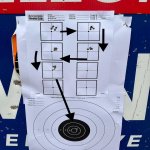In a world where a shooter didn’t have to worry about the cost of .22LR match ammo (and what a wonderful world that would be), how would the best ammo be chosen? Some might choose by price – that is, the most expensive variety. Some might choose by the ammo’s reputation, by what others say shoots well. Some pick the ammo that produces the smallest groups. But perhaps none of these methods is the best.
In most cases, many shooters trust that ammo testing to choose the best ammo for a rifle should be straightforward. If enough different kinds of ammo are tested, one or a few should be performing better than others. And if enough of that ammo is tested the results can confirm the reason for choosing one ammo over another.
As many shooters are aware, match ammo is made in batches or lots and not all lots of the same kind or variety of ammo will perform equally.
This post is not, however, about lot testing, the process by which as many different lots of match ammo that can be obtained – possibly of the same variety, possibly of several varieties – are tested and compared to determine the best performer.
This post is much simpler as it’s about only four different ammos. The question is simple: which one of them is the best performing. It’s worth point out that probably none of these ammos are available at dealers any longer.
The four ammos were all bought late in 2020, just over a year ago. I ordered these ammos after some rudimentary and ultimately unsatisfactory testing last year in October. That testing was not ideal because temperatures were uncomfortably cold and each day there was too much wind at the range for reliable results. But time was short, and I tested as best I could.
As it happened, I didn’t have the chance to shoot any of the ammos in better conditions until this shooting season, which for me is now over.
As often suggested by Horseman2 on this forum, when done in very good conditions, testing at 100 yards by shooting ten-shot groups provides an excellent opportunity to assess ammo. Ten-shot groups are a more reliable indicator of how an ammo shoots than do five-shot groups. And 100 yards shows where good ammo really shines, and poorly performing ammo is obvious.
The results that will be shown below are from August to October 2021, the period during which I shot at 100 yards. The number of groups shot by each ammo are only a reflection of how much ammo I had available for 100-yard shooting, not an indication of anything else.
I sought to shoot when conditions were good, that is, not windy. Ideally, there was no wind at all, but to be fair it’s not possible to always shoot in zero wind.
In most cases, many shooters trust that ammo testing to choose the best ammo for a rifle should be straightforward. If enough different kinds of ammo are tested, one or a few should be performing better than others. And if enough of that ammo is tested the results can confirm the reason for choosing one ammo over another.
As many shooters are aware, match ammo is made in batches or lots and not all lots of the same kind or variety of ammo will perform equally.
This post is not, however, about lot testing, the process by which as many different lots of match ammo that can be obtained – possibly of the same variety, possibly of several varieties – are tested and compared to determine the best performer.
This post is much simpler as it’s about only four different ammos. The question is simple: which one of them is the best performing. It’s worth point out that probably none of these ammos are available at dealers any longer.
The four ammos were all bought late in 2020, just over a year ago. I ordered these ammos after some rudimentary and ultimately unsatisfactory testing last year in October. That testing was not ideal because temperatures were uncomfortably cold and each day there was too much wind at the range for reliable results. But time was short, and I tested as best I could.
As it happened, I didn’t have the chance to shoot any of the ammos in better conditions until this shooting season, which for me is now over.
As often suggested by Horseman2 on this forum, when done in very good conditions, testing at 100 yards by shooting ten-shot groups provides an excellent opportunity to assess ammo. Ten-shot groups are a more reliable indicator of how an ammo shoots than do five-shot groups. And 100 yards shows where good ammo really shines, and poorly performing ammo is obvious.
The results that will be shown below are from August to October 2021, the period during which I shot at 100 yards. The number of groups shot by each ammo are only a reflection of how much ammo I had available for 100-yard shooting, not an indication of anything else.
I sought to shoot when conditions were good, that is, not windy. Ideally, there was no wind at all, but to be fair it’s not possible to always shoot in zero wind.
















































































